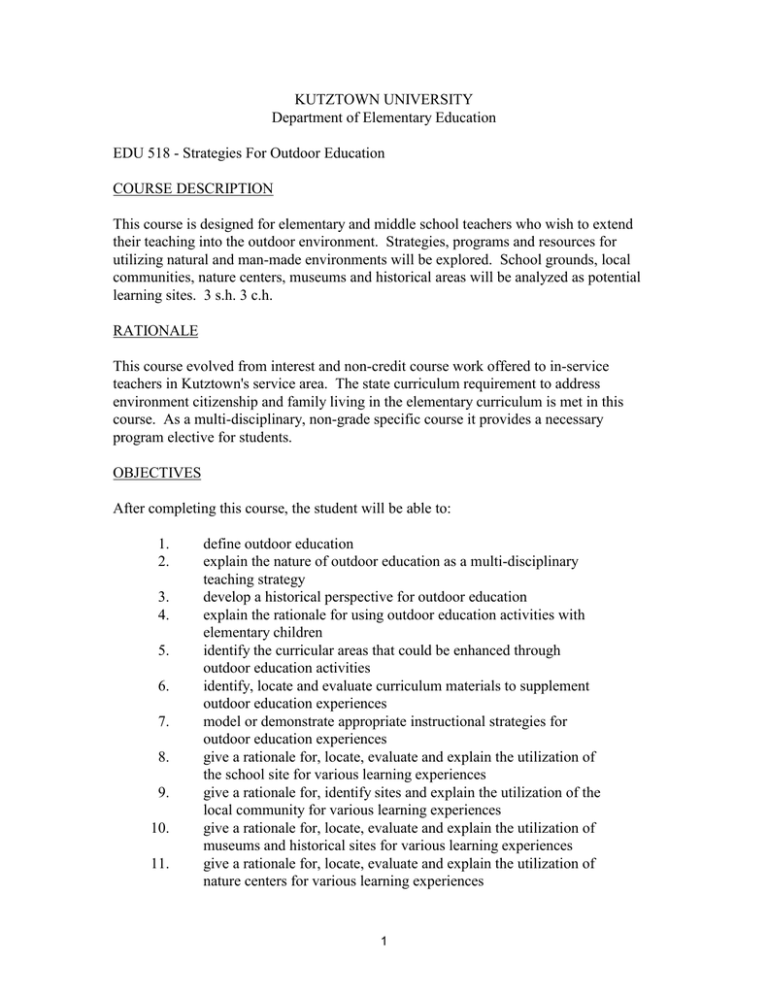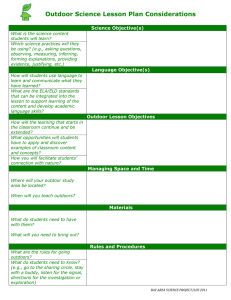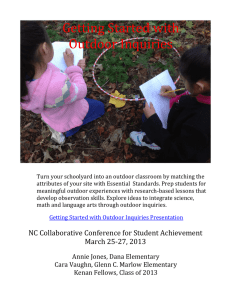KUTZTOWN UNIVERSITY Department of Elementary Education
advertisement

KUTZTOWN UNIVERSITY Department of Elementary Education EDU 518 - Strategies For Outdoor Education COURSE DESCRIPTION This course is designed for elementary and middle school teachers who wish to extend their teaching into the outdoor environment. Strategies, programs and resources for utilizing natural and man-made environments will be explored. School grounds, local communities, nature centers, museums and historical areas will be analyzed as potential learning sites. 3 s.h. 3 c.h. RATIONALE This course evolved from interest and non-credit course work offered to in-service teachers in Kutztown's service area. The state curriculum requirement to address environment citizenship and family living in the elementary curriculum is met in this course. As a multi-disciplinary, non-grade specific course it provides a necessary program elective for students. OBJECTIVES After completing this course, the student will be able to: 1. 2. 3. 4. 5. 6. 7. 8. 9. 10. 11. define outdoor education explain the nature of outdoor education as a multi-disciplinary teaching strategy develop a historical perspective for outdoor education explain the rationale for using outdoor education activities with elementary children identify the curricular areas that could be enhanced through outdoor education activities identify, locate and evaluate curriculum materials to supplement outdoor education experiences model or demonstrate appropriate instructional strategies for outdoor education experiences give a rationale for, locate, evaluate and explain the utilization of the school site for various learning experiences give a rationale for, identify sites and explain the utilization of the local community for various learning experiences give a rationale for, locate, evaluate and explain the utilization of museums and historical sites for various learning experiences give a rationale for, locate, evaluate and explain the utilization of nature centers for various learning experiences 1 12. give a rationale for, locate and evaluate sites and explain the programming for a residential outdoor education experience ASSESSMENT Assessment of each teacher candidate’s level of accomplishment with reference to the course objectives will be based upon a subset of the following: Lesson Plans 1. Successful development of lesson plans in content. (Environment and ecology, history, and the social sciences that integrate the Pennsylvania State Academic Standards). 2. Grade level demographics and corresponds to classroom in which they teach 3. Location based on visits to local outdoor resources which can be used by the school districts in the Kutztown University service area. COURSE OUTLINE I. The Nature and Scope of Outdoor Education A. Definitions B. Characteristics 1. a strategy 2. a content discipline II. A Historical Perspective A. Origins B. Development C. Trends III. Rationale for Outdoor Education A. Inspiration B. Skill development 1. observation 2. problem solving 3. critical thinking 4. research 5. socialization 6. communication C. Factual and conceptual knowledge 1. Arts and literature 2. Social sciences 3. Philosophy, ethics and values 4. Science and technology IV. Curriculum Implications for Outdoor Education A. Multidisciplinary 2 B. Across grade levels V. Methods and Materials for Outdoor Education A. Methods 1. inquiry 2. guided discovery 3. cooperative learning 4. laboratory 5. field trip 6. computer simulation 7. problem solving B. Materials 1. commercial publishing programs a. print b. non-print c. computer software 2. teacher made a. print b. non-print c. computer software 3. free materials a. print b. non-print VI. Utilization's of the School Site A. Site surveying B. Criteria for evaluation of site usability C. Integration of site and curriculum VII. Community Studies A. Strategies for identifying resources B. Criteria for evaluation of community resources C. Implementation models VIII. Utilization of Museums and Historical Sites A. Strategies to locate resources B. Criteria for evaluation of resources C. Procedures for integration of resources and curriculum IX. Utilization of Nature Centers and Wildlife Sanctuaries A. Strategies to locate resources B. Criteria for evaluation of resources C. Procedures for integration of resources and curriculum X. Residential Outdoor Education 3 A. B. Outdoor Schools 1. strategies to locate resources 2. criteria for evaluation of resources 3. procedure for integration of resources and curriculum School Camping 1. planning 2. staffing 3. financing 4. operating 5. evaluating 4 Instructional Resources Abruscato, J. (1988). Teaching Children Science. (2nd ed.) Englewood Cliffs, NJ: Prentice-Hall, Inc. Adkins, C., & Simmons, B. (2002). Outdoor, experiential, & environmental education: Converging or diverging approaches? ERIC Digest, EDO-RC-02-1 [PDF] Allen, R. F., Foti, C.P., Ulrich, D.M., Wollard, S.H. (1975). Deciding How to Live on Spaceship Earth: The Ethics of Environmental Concern. Evanston, IL: McDougal, Little & Co. American Association for Health, Physical Education and Recreation. (1986). Outdoor Education. (Julian Smith). Washington, DC. __________. (1957). Outdoor Education for American Youth. (prepared by AAHPER. Smith, Julian W.) Washington, DC. Andrew, William A., Moore, Donna D., Stoker, Daniel G. (1974). Teachers Guide for Contours: Studies of the Environment. Englewood Cliffs, NJ: Prentice Hall. __________. (1974). A Guide to the Study of Environmental Pollution. Engelwood Cliffs, NJ: Prentice Hall. __________. (1974). A Guide to the Study of Freshwater Ecology. Engelwood Cliffs, NJ: Prentice Hall. __________. (1974). A Guide to the Study of Terrestrial Ecology. Englewood Cliffs, NJ: Prentice Hall. Association of Classroom Teachers. (1970). Man and his Enviroment: An Introduction to Using. NEA. Bates, Marston. (1960). The Forest and the Sea: A Look at the Economy of Nature, and the Ecology of Man. New York: Random House. Bradshaw, Michael J. (1977). Earth: The Living Planet. New York: Wiley. Brainerd, John W. (1971). Nature Study for Conservation: A Handbook for Environmental Education. New York: MacMillan. Brennan, Mathew J. ed. (1969). People and Their Environment, Teachers' Curriculum Guide to Conservation, Chicago: Fergusoon. Brown, C. S. (1988). Like It Was: A Complete Guide to Writing Oral History. New York: Teacher and Writers Collaborative. Brubaker, Sterling. To Live on Earth: Man and His Environment in Perspective. Baltimore, MD: John Hopkins Press. Bureau of State Parks. (1969). Environmental Education Center Nolde Forest State Park. Harrisburg, PA. Culkin, D. F. & Kirsch, S. L. (1986). Managing Human Resources in Recreation, Parks, and Leisure Services. New York: Macmillan. Developed Under National Science Foundation. Living in Water. An Aquatic Science Curriculum for Grades 4-6. (1987). National Aquarium in Baltimore. Hammerman, Donald, Hammerman, Wm. M., (1973). Outdoor Education: A Book of Readings. (2nd ed.). Minneapolis, MN: Burgess. Hammerman, Donald, Hammerman, Wm. M., Hammerman, Elizabeth. (1985). 5 Teaching in the Outdoors. Danville, IL: The Interstate Printers and Publishers, Inc. Jensen, C.R. (1985). Outdoor Recreation in America. Minneapolis, MN: Burgess. Justman, Jason. Retrieved September 10, 2005, from www.commtechlab.msu.edu Leopold, Aldo. (1972). A Sand County Almanac. New York: Ballantine. Lewis-Walters, J. and Hamilton, L. (1993). Integrating Environmental Education into the Curriculum....Painlessly. Bloomington, IN: National Educational Service. Link, Michael. (1981). Outdoor Education, A Manual for Teaching in Nature's Classroom. Englewood Cliffs, NJ: Prentice-Hall, Inc. Lippson, Alice Jane and Lippson, Robert L. (1984) Life in Chesapeake Bay. Baltimore, MD: The John Hopkins University Press. McAlester, V. and McAlester, L. (1989). A Field Guide to American Houses. New York: Knopf. MacMillan, Dorothy Lou. (1956). School Camping and Outdoor Education. Dubuque, IA: W.C. Brown. Matre, Steve Van. (1979). Acclimatization: A Sensory and Conceptual Approach to Ecological Involvement. Martinsville, IN: American Camping Association. __________. (1979). Acclimatizing: A Personal and Reflective Approach to a Nature Relationship. Mountainville, IN: American Camping Association. __________. (1979). Sunship Earth. Martinsville, IN: American Camping Association. Milliken, Margaret, Hamer, Austin F, and McDonald Ernest C. (1968). Study Manual for Outdoor Learning. Minneapolis, MN: Burgess. Morris, Talyo. (1972). The Walk of the Conscious Ants. New York: Knopf. Munzer, Martha E. and Cravjal. Joan. (1968). Conservation Education: A Selected Bibliography. Danville, IL: The Interstate. Neill, James. Retrieved September 9, 2005, from www.wilderdom.com Nobile, Phillip, and Deedy. John. (1972). The Complete Ecology Fact Book. Doubleday. Russell, H. R. (2001). Ten minute field trips: A teacher’s guide to using the school for environmental studies. Arlington, VA: NSTA Press. Sale, Larry L. and Lee, Ernest W. (1972). Evnironmental Education in the Elementary School. New York: Holt Rinehart and Winston. Saveland, Robert N. (1976). Handbook of Environmental Education: With International Case Studies. London England: John Wiley. Schoenfield, Clay. (1971). Outline of Environmental Education. Dembar Educational Research Services, Inc. Schug, Mark C. and Beery, R. "Eds." (1984). Community Study: Application and Opportunities. National Council for the Social Studies Bulletin, No. 73. Washington, DC: National Council for the Social Studies. Scramm, Wilbur Lang. (1969). Classroom Out-of-Doors: Education Through School Camping. Kalamazo, MI: Sequoia. Shomon, Joseph James. (1969). A Nature Center for Your Community. New 6 York: National Audobon Society. Smith, Julian W. and Carlson, R. E. and Donaldson, G. W. and Masters, G. B. (1972). Outdoor Education. Englewood Cliffs, NJ: Prentice Hall. Smith, Julian W. (1956-64). Outdoor Education. American Association for Health, Physical Education and Recreation. Washington, DC: NEA. Strapp, William B. (1965). Integrating Conservation and Outdoor Education Into the Curriculum. Minneapolis, MN: Burgess Co. Storer, John G. (1968). Man in the Web of Life. New York: NAL. Swan, Malcolm, D. (Ed.) (1987). Tips and Tricks in Outdoor Education: Approaches to Providing Children with Educational Experiences in the Outdoors. Danville, IL: The Interstate Printers and Publishers, Inc. Tanner, R. Thomas. (1974). Ecology, Environment, and Education. Lincoln, NB: Professional Educators Publications. The Ohio State University. (2005). EEATP. Environmental education: Can it be defined? Retrieved September 10, 2005 from http://www.ag.ohiostate.edu/~eetap/pdf/info14/pdf The Ohio State University. (2005). Thesaurus of environmental education terms. Retrieved September 10, 2005 from http://www.ag.ohiostate.edu/~eetap/pdf/eeterms.pdf The George Lucas Educational Foundation (GLEF). Retrieved September 9, 2005, from www.edutopia.org Tradeushuk, Patrick. Retrieved November 17, 2005, from www.fieldtrip.com Troost, Cornelius J. and Altman, Harold. (1972). Environmental Education: A Sourcebook. New York: Wiley. Voris, H. H. and Sedzielarz, M. and Blacknon, C.P. (1986). Teach the Mind Touch the Spirit: A Guide to Focused Field Trips. Chicago: Field Museum of Natural History. Western Regional Environmental Education Council. (1983). Project Wild Elementary Activity Guide. Boulder, Co: Project Wild. Williams, Catharine. (1975). The Community As Textbook. Bloomington, ID: The Phi Delta Kappa Eductional Foundation. 7


